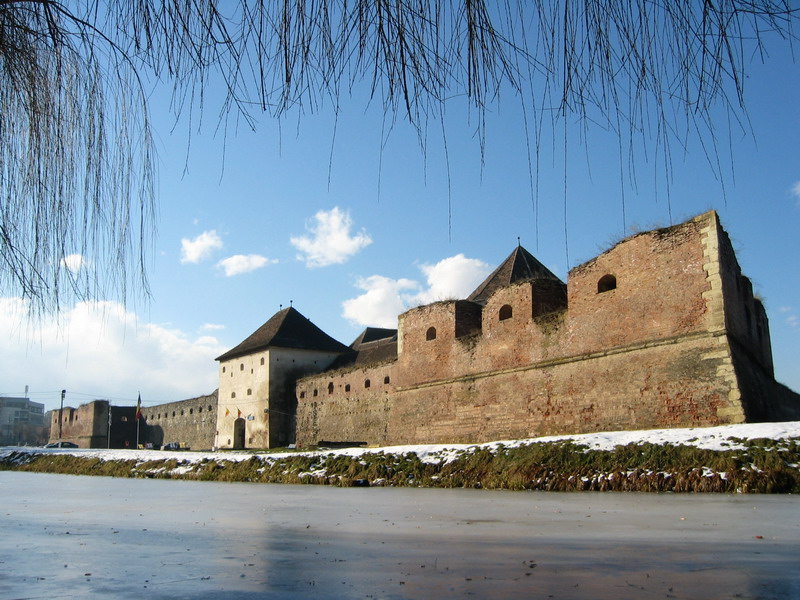- Făgăraş
Infobox Settlement
subdivision_type = Country
subdivision_name = ROU
timezone=EET
utc_offset=+2
timezone_DST=EEST
utc_offset_DST=+3
map_caption = Location of Făgăraş
|official_name=Făgăraş
pushpin_
pushpin_label_position =
pushpin_map_caption =Location of Făgăraş
pushpin_mapsize =
image_shield=
subdivision_type1=County
subdivision_name1=Braşov County
subdivision_type2=Status
subdivision_name2=Autolink|Municipality
settlement_type=Municipality|
leader_title=Mayor
leader_name=Mănduc Constantin Sorin
area_total_km2=
population_as_of=2002
population_total=40126|latd=45|latm=50|lats=41|latNS=N|longd=24|longm=58|longs=27|longEW=E|
website=http://www.primaria-fagaras.ro/Făgăraş ( _de. Fogarasch, _hu. Fogaras) is a city in central
Romania , located inBraşov County . It lies on theOlt River and has a population of 35,400 as of 2004.Although the city has become almost totally Romanian-populated through Saxon and Hungarian emigration, the diverse background is still obvious. The most important attraction points in the city are the fortress, Radu Negru High school, the Reformed Church and the local
Catholic church.Name
The name is alleged to derive from the Romanian word for "
beech " ("fag"). Another source of the name is given byfolk etymology to be Hungarian, as the rendering of "wood" ("fa") and "money" ("garas"), with legends stating that money made of wood had been used to pay the peasants who built the fortress around 1310.History
Făgăraş was during the
Middle Ages , together withAmlaş , a traditionalVlach enclave in Transylvania. The first written document mentioningRomanians in Transylvania referred toVlach lands ("Terra Blacorum") in theFogaras Region in 1222. (In this document,Andrew II of Hungary gaveBurzenland and the Cuman territories South of Burzenland up to the Danube to theTeutonic Knights .) After the Tatar invasion in 1241-1242, Saxons settled in the area. In 1369,Louis I of Hungary gave the Royal Estates of Făgăraş to his vassal,Vladislav I of Wallachia , the territory remained in the possession of Wallachian Princes until 1464.Except for this period of Wallachian rule, the town itself was centre of the surrounding royal estates belonging to the Hungarian kings. During the rule of Transylvanian Prince
Gabriel Bethlen (1613-1629), the city became an economic role model city in the southern regions of the realm. Bethlen rebuilt the fortress entirely.Ever since that time, Făgăraş was the residence of the wives of Transylvanian Princes, as an equivalent of
Veszprém , the Hungarian "city of queens". Of these,Zsuzsanna Lorántffy , the widow ofGeorge I Rákóczy established a Vlach (Romanian) school here in 1658. Probably the most prominent of the princesses residing in the town was the orphan PrincessKata Bethlen (1700-1759), buried in front of the Reformed church. The church holds several precious relics of her life. Her bridal gown, with the familycoat of arms embroidered on it, and her bridal veil now covers the altar table. Both are made of yellowsilk .Făgăraş was the site of several
Transylvanian Diet s, mostly during the reign ofMichael I Apafi .The church was built around 1715-1740. Not far from it is the Radu Negru high school - built around 1909, it was originally a Hungarian language middle school where
Babits Mihály taught for a while.A local legend says that Negru Vodă left the central fortress to travel south past the
Transylvanian Alps to become the founder of the Principality ofWallachia , althoughBasarab I is traditionally known as the 14th century founder of the state. By the end of the 12th century the fortress itself was made of wood, but it was reinforced in the 14th century and became a stone fortification.In the 20th century, Făgăraş's castle was used as a stronghold by the
Communist State of Romania. During the 1950s it was a prison for opponents anddissident s. After the fall of theCommunist State in 1989, the castle has been restored and is currently used as a museum and library.The city's economy was badly shaken by the disappearance of most of its industries following the Revolution, critical hardships, and reforms. A large part of the city population left as guest workers to
Italy ,Spain , orIreland .ee also
*
Făgăraş Mountains
Wikimedia Foundation. 2010.


